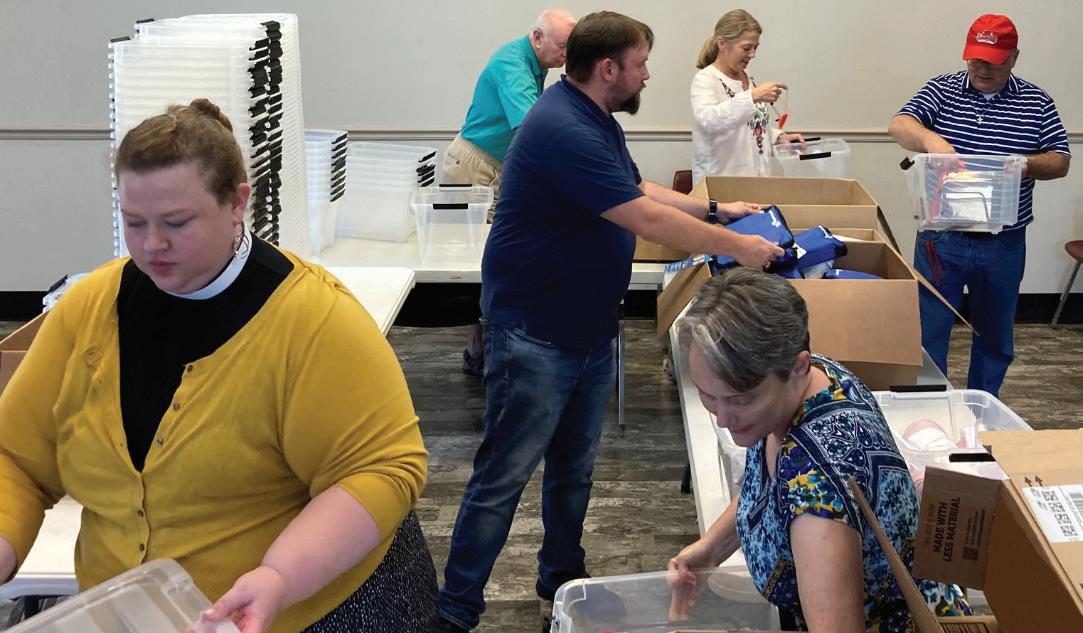
2 minute read
Overview from the Rev. Stacy Stringer, Episcopal Diocese of Texas Director of Disaster Response
In summer 2022, Charles Teel, parishioner with St. Mark’s Episcopal, Beaumont, led his congregation in a disaster preparedness mission to benefit several southeast Texas Episcopal congregations and their communities. He was aware that the region’s most vulnerable neighbors were still recovering from a series of storms dating back several years, plus an ongoing pandemic. In response, St. Mark’s Episcopal’s summer project aimed to better equip vulnerable families for the next disruption.
“Storms will always have a level of impact on people’s physical and mental health as it disrupts their lives,” Teel said. “But I know, from what I’ve personally seen over the years, that being prepared can make a world of difference in how big or small that impact is on someone, their family and their home.”
During the summer project, church and community members in multiple counties gathered to assemble disaster kits, learn about facets of disaster readiness and distribute the kits. Through ties with other organizations and through neighbors knowing neighbors, more than 100 families received a “go kit” to have on standby.
Faith-based organizations have always been at the forefront of disaster response, and this includes being ready for the “next one” to the best of our abilities. We’ve learned that the basic ingredients of preparedness function across all hazards. One powerful resource in times of need are trusted networks, and in 2022 many of our congregations and institutions excelled in leading and in participating in regional readiness efforts.
Ranging from chemical explosions to winter storms, hurricanes, floods, tornadoes, wildfires, offshore accidents, bomb threats, school violence and a pandemic, the Diocese of Texas has been a key responder in relief and recovery. The scale, scope and kind of disasters have increased over the years, and so has the frequency. To be wise and faithful stewards of our people, plants, and communities, it is vital that we expand our toolkits to include preparedness plans.
Planning begins at the local level, and knowing our neighbors is an excellent beginning point. We knit together a lifeline that connects communities by exchanging vital information, sharing needed items, and being there for each other. Congregations that have invested in relationships with their neighbors, especially vulnerable families, are uniquely positioned to be trusted partners in this mission field.
Congregation preparedness can include resources provided by our Disaster Readiness program. These include tools for preparing congregation facilities and members as well as those which aid in community outreach. For example, in 2022 some congregations listened to their vulnerable neighbors to learn – and to secure - what they would find most helpful to have on hand at home before that “next one” arrives. Preparedness grants from Episcopal Diocese of Texas Disaster Readiness, supported by Episcopal Relief & Development, helped with the procurement of those supplies.
The bomb cyclone in December 2022,, which brought life-threatening weather to the entire state, activated congregations who were staying tuned to weather forecasts. Bishop C. Andrew Doyle activated our diocesan emergency communications system to connect with heads of congregations prior to and during the arctic blast. Outreach ministries rapidly activated their networks and secured items to assist unhoused neighbors and vulnerable families.
Perfect preparedness is not a realistic goal, but the impact of small things can and does produce large benefits, much of which we will never see. Tragedies become less tragic through an ounce of planning, and being a little bit ready now can bring a lot of relief later. Let us trust the power of God over tiny things: Preparedness the size of a mustard seed yields mighty results!
(Story by Director of Disaster Response the Rev. Stacy Stringer originally appeared in the “Texas Diocese.” Please contact Stringer if your congregation is interested in what a preparedness project might look like.)









